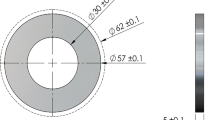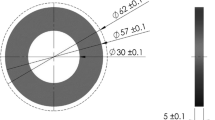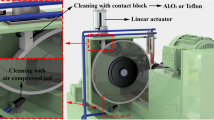Abstract
The final quality of mechanical components has been increasingly desired in the industry. This final quality is directly linked to surface roughness, geometric deviations, and mechanical integrity of components subjected to machining processes. For that, the industry makes use of cutting fluids so that it is possible to achieve such conditions. In the case of grinding, the application of cutting fluid in abundance allows a great reduction in temperature, as well as a better removal of chips from the cutting surface of the wheel. However, the problems generated by the cutting fluid related to environmental and labor liabilities have increasingly led to the development of effective techniques for grinding with minimal amounts of cutting fluid. The difficulties linked to the use of MQL are concentrated in the low rate of heat removal and in the clogging of the cutting surface, varying according to the type of grinding wheel applied. In this sense, the present work proposes comparison during the cylindrical grinding of hardened steel under conventional lubrication conditions, minimum quantity lubricant (MQL), cooled air MQL (MQL + CA), and MQL with wheel cleaning jet (MQL + WCJ), using aluminum oxide (Al2O3) and CBN grinding wheels. The results are presented in terms of surface roughness, roundness error, microhardness, tangential force, diametrical wear of the grinding wheels, and G-ratio. The application of MQL + CA and MQL + WCJ can improve the use of MQL. In terms of roughness, the MQL + WCJ presents values close to the conventional increase of 8.8%. Roundness errors were reduced by up to 36.3% during the application of MQL + CA and MQL + WCJ and up to 10.5% for the tangential force. Thus, these advanced techniques have shown that the conditions are feasible for the application of pure MQL towards an eco-friendly grinding process.













Similar content being viewed by others
References
Holmberg K, Andersson P, Erdemir A (2012) Global energy consumption due to friction in passenger cars. Tribol Int 47:221–234. https://doi.org/10.1016/j.triboint.2011.11.022
Hsu S, Ying C, Zhao F (2014) The nature of friction: a critical assessment. Friction 2:1–26. https://doi.org/10.1007/s40544-013-0033-z
Bruzzone AAG, Costa HL, Lonardo PM, Lucca DA (2008) Advances in engineered surfaces for functional performance. CIRP Ann - Manuf Technol 57:750–769. https://doi.org/10.1016/j.cirp.2008.09.003
Rodriguez RL, Lopes JC, Garcia MV, Tarrento GE, Rodrigues AR, de Ângelo Sanchez LE, de Mello HJ, de Aguiar PR, Bianchi EC (2020) Grinding process applied to workpieces with different geometries interrupted using CBN wheel. Int J Adv Manuf Technol 107:1265–1275. https://doi.org/10.1007/s00170-020-05122-2
de Mello HJ, de Mello DR, Rodriguez RL, Lopes JC, da Silva RB, de Angelo Sanchez LE, Hildebrandt RA, Aguiar PR, Bianchi EC (2018) Contribution to cylindrical grinding of interrupted surfaces of hardened steel with medium grit wheel. Int J Adv Manuf Technol 95:4049–4057. https://doi.org/10.1007/s00170-017-1552-y
Ribeiro FSF, Lopes JC, Garcia MV, et al (2020) Grinding assessment of workpieces with different interrupted geometries using aluminum oxide wheel with vitrified bond. Int J Adv Manuf Technol 1–11. https://doi.org/10.1007/s00170-020-05500-w
Abdelrazek AH, Choudhury IA, Nukman Y, Kazi SN (2020) Metal cutting lubricants and cutting tools: a review on the performance improvement and sustainability assessment. Int J Adv Manuf Technol 106:4221–4245. https://doi.org/10.1007/s00170-019-04890-w
SHAW MC, COOKSON JO (2005) Metal cutting principles. Oxford university press, New York
Trent EM, Wright PK (2000) Heat in metal cutting. In: Metal Cutting, 4Th edn. Butterworth-Heinemann
Vyas A, Shaw MC (2008) Mechanics of saw-tooth chip formation in metal cutting. J Manuf Sci Eng 121:163–172. https://doi.org/10.1115/1.2831200
de Martini FL, Lopes JC, Ribeiro FSF et al (2019) Thermal model for surface grinding application. Int J Adv Manuf Technol 104:2783–2793. https://doi.org/10.1007/s00170-019-04101-6
Ramesh R, Mannan MA, Poo AN (2000) Error compensation in machine tools — a review Part I : geometric , cutting-force induced and fixture- dependent errors. Int J Mach Tools Manuf 40:1235–1256
Bianchi EC, Rodriguez RL, Hildebrandt RA, Lopes JC, de Mello HJ, da Silva RB, de Aguiar PR (2018) Plunge cylindrical grinding with the minimum quantity lubrication coolant technique assisted with wheel cleaning system. Int J Adv Manuf Technol 95:2907–2916. https://doi.org/10.1007/s00170-017-1396-5
Bianchi EC, Destro RS, Oikawa MH et al (2010) The minimum quantity of lubricant (MQL) technique in the surface grinding of steel. WIT Trans Eng Sci 66:249–260. https://doi.org/10.2495/TD100211
Talon AG, Lopes JC, Tavares AB, Sato BK, Rodrigues AR, Genovez MC, Dinis Pinto TA, de Mello HJ, Aguiar PR, Bianchi EC (2019) Effect of hardened steel grinding using aluminum oxide wheel under application of cutting fluid with corrosion inhibitors. Int J Adv Manuf Technol 104:1437–1448. https://doi.org/10.1007/s00170-019-04005-5
Umbrello D (2013) Analysis of the white layers formed during machining of hardened AISI 52100 steel under dry and cryogenic cooling conditions. Int J Adv Manuf Technol 64:633–642. https://doi.org/10.1007/s00170-012-4073-8
Mao C, Zhou Z, Zhang J, Huang X, Gu D (2011) An experimental investigation of affected layers formed in grinding of AISI 52100 steel. Int J Adv Manuf Technol 54:515–523. https://doi.org/10.1007/s00170-010-2965-z
Umbrello D, Filice L (2009) Improving surface integrity in orthogonal machining of hardened AISI 52100 steel by modeling white and dark layers formation. CIRP Ann - Manuf Technol 58:73–76. https://doi.org/10.1016/j.cirp.2009.03.106
Javaroni RL, Lopes JC, Garcia MV, Ribeiro FSF, de Angelo Sanchez LE, de Mello HJ, Aguiar PR, Bianchi EC (2020) Grinding hardened steel using MQL associated with cleaning system and cBN wheel. Int J Adv Manuf Technol 107:2065–2080. https://doi.org/10.1007/s00170-020-05169-1
Alexandre FA, Lopes WN, Lofrano Dotto FR, Ferreira FI, Aguiar PR, Bianchi EC, Lopes JC (2018) Tool condition monitoring of aluminum oxide grinding wheel using AE and fuzzy model. Int J Adv Manuf Technol 96:67–79. https://doi.org/10.1007/s00170-018-1582-0
Kara F, Cicek A, Demir H (2013) Multiple regression and ann models for surface qualification of cryogenically-treated AISI 52100 bearing steel. J Balk Tribol Assoc 19:570–584
Özbek O, Saruhan H (2020) The effect of vibration and cutting zone temperature on surface roughness and tool wear in eco-friendly MQL turning of AISI D2. J Mater Res Technol 9:1–11. https://doi.org/10.1016/j.jmrt.2020.01.010
Alexandre FA, Lopes JC, de Martini FL et al (2020) Depth of dressing optimization in CBN wheels of different friabilities using acoustic emission (AE) technique. Int J Adv Manuf Technol 106:5225–5240. https://doi.org/10.1007/s00170-020-04994-8
de Martini FL, Lopes JC, Volpato RS et al (2018) Comparative analysis of two CBN grinding wheels performance in nodular cast iron plunge grinding. Int J Adv Manuf Technol 98:237–249. https://doi.org/10.1007/s00170-018-2133-4
Marinescu ID, Hitchiner M, Uhlmann E, Rowe WB (2007) Handbook of machining with grinding wheels, 1st edn. CRC Press, New York
Lopes JC, de Martini FL, Domingues BB et al (2019) Effect of CBN grain friability in hardened steel plunge grinding. Int J Adv Manuf Technol 103:1567–1577. https://doi.org/10.1007/s00170-019-03654-w
Sato BK, Rodriguez RL, Talon AG, Lopes JC, Mello HJ, Aguiar PR, Bianchi EC (2019) Grinding performance of AISI D6 steel using CBN wheel vitrified and resinoid bonded. Int J Adv Manuf Technol 105:2167–2182. https://doi.org/10.1007/s00170-019-04407-5
Talon AG, Lopes JC, Sato BK et al (2020) Grinding performance of hardened steel: a study about the application of different cutting fluids with corrosion inhibitor. Int J Adv Manuf Technol 1–14. https://doi.org/10.1007/s00170-020-05598-y
Garcia MV, Lopes JC, Diniz AE, Rodrigues AR, Volpato RS, Sanchez LEA, de Mello HJ, Aguiar PR, Bianchi EC (2020) Grinding performance of bearing steel using MQL under different dilutions and wheel cleaning for green manufacture. J Clean Prod 257:120376. https://doi.org/10.1016/j.jclepro.2020.120376
Rodriguez RL, Lopes JC, Mancini SD, de Ângelo Sanchez LE, de Almeida Varasquim FMF, Volpato RS, de Mello HJ, de Aguiar PR, Bianchi EC (2019) Contribution for minimization the usage of cutting fluids in CFRP grinding. Int J Adv Manuf Technol 103:487–497. https://doi.org/10.1007/s00170-019-03529-0
Lopes JC, de Martini FL, Garcia MV et al (2020) Performance of austempered ductile iron (ADI) grinding using diluted oil in MQL combined with wheel cleaning jet and different CBN grains friability. Int J Adv Manuf Technol 107:1805–1818. https://doi.org/10.1007/s00170-020-05142-y
Lopes JC, Ventura CEH, Rodriguez RL, Talon AG, Volpato RS, Sato BK, de Mello HJ, de Aguiar PR, Bianchi EC (2018) Application of minimum quantity lubrication with addition of water in the grinding of alumina. Int J Adv Manuf Technol 97:1951–1959. https://doi.org/10.1007/s00170-018-2085-8
de Moraes DL, Garcia MV, Lopes JC, Ribeiro FSF, de Angelo Sanchez LE, Foschini CR, de Mello HJ, Aguiar PR, Bianchi EC (2019) Performance of SAE 52100 steel grinding using MQL technique with pure and diluted oil. Int J Adv Manuf Technol 105:4211–4223. https://doi.org/10.1007/s00170-019-04582-5
Javaroni RL, Lopes JC, Sato BK, Sanchez LEA, Mello HJ, Aguiar PR, Bianchi EC (2019) Minimum quantity of lubrication (MQL) as an eco-friendly alternative to the cutting fluids in advanced ceramics grinding. Int J Adv Manuf Technol 103:2809–2819. https://doi.org/10.1007/s00170-019-03697-z
Munhoz MR, Dias LG, Breganon R, Ribeiro FSF, de Souza Gonçalves JF, Hashimoto EM, da Silva Júnior CE (2020) Analysis of the surface roughness obtained by the abrasive flow machining process using an abrasive paste with oiticica oil. Int J Adv Manuf Technol 106:5061–5070. https://doi.org/10.1007/s00170-019-04920-7
Li B, Li C, Zhang Y, Wang Y, Jia D, Yang M, Zhang N, Wu Q, Han Z, Sun K (2017) Heat transfer performance of MQL grinding with different nanofluids for Ni-based alloys using vegetable oil. J Clean Prod 154:1–11. https://doi.org/10.1016/j.jclepro.2017.03.213
Hadad MJJ, Tawakoli T, Sadeghi MHH, Sadeghi B (2012) Temperature and energy partition in minimum quantity lubrication-MQL grinding process. Int J Mach Tools Manuf 54–55:10–17. https://doi.org/10.1016/j.ijmachtools.2011.11.010
Shokrani A, Dhokia V, Newman ST (2015) A techno-health study of the use of cutting fluids and future alternatives. 625–632. https://doi.org/10.14809/faim.2014.0625
Benedicto E, Carou D, Rubio EM (2017) Technical, economic and environmental review of the lubrication/cooling systems used in machining processes. Procedia Engineering. The Author(s), In, pp 99–116
Lopes JC, Garcia MV, Volpato RS, de Mello HJ, Ribeiro FSF, de Angelo Sanchez LE, de Oliveira Rocha K, Neto LD, Aguiar PR, Bianchi EC (2020) Application of MQL technique using TiO2 nanoparticles compared to MQL simultaneous to the grinding wheel cleaning jet. Int J Adv Manuf Technol 106:2205–2218. https://doi.org/10.1007/s00170-019-04760-5
Setti D, Sinha MK, Ghosh S, Venkateswara Rao P (2015) Performance evaluation of Ti–6Al–4V grinding using chip formation and coefficient of friction under the influence of nanofluids. Int J Mach Tools Manuf 88:237–248. https://doi.org/10.1016/j.ijmachtools.2014.10.005
Zhang J, Li C, Zhang Y, Yang M, Jia D, Liu G, Hou Y, Li R, Zhang N, Wu Q, Cao H (2018) Experimental assessment of an environmentally friendly grinding process using nanofluid minimum quantity lubrication with cryogenic air. J Clean Prod 193:236–248. https://doi.org/10.1016/j.jclepro.2018.05.009
da Silva AE, Lopes JC, Daniel DM, de Moraes DL, Garcia MV, Ribeiro FSF, de Mello HJ, Sanchez LEDA, Aguiar PR, Bianchi EC (2020) Behavior of austempered ductile iron (ADI) grinding using different MQL dilutions and CBN wheels with low and high friability. Int J Adv Manuf Technol 107:4373–4387. https://doi.org/10.1007/s00170-020-05347-1
Moretti GB, de Moraes DL, Garcia MV, Lopes JC, Ribeiro FSF, Foschini CR, de Mello HJ, Sanchez LEDA, Aguiar PR, Bianchi EC (2020) Grinding behavior of austempered ductile iron: a study about the effect of pure and diluted MQL technique applying different friability wheels. Int J Adv Manuf Technol 108:3661–3673. https://doi.org/10.1007/s00170-020-05577-3
Bianchi EC, Rodriguez RL, Hildebrandt RA, Lopes JC, de Mello HJ, de Aguiar PR, da Silva RB, Jackson MJ (2019) Application of the auxiliary wheel cleaning jet in the plunge cylindrical grinding with minimum quantity lubrication technique under various flow rates. Proc Inst Mech Eng Part B J Eng Manuf 233:1144–1156. https://doi.org/10.1177/0954405418774599
Bianchi EC, Sato BK, Sales AR, Lopes JC, de Mello HJ, de Angelo Sanchez LE, Diniz AE, Aguiar PR (2018) Evaluating the effect of the compressed air wheel cleaning in grinding the AISI 4340 steel with CBN and MQL with water. Int J Adv Manuf Technol 95:2855–2864. https://doi.org/10.1007/s00170-017-1433-4
Lopes JC, Ventura CEH, de M. Fernandes L, et al (2019) Application of a wheel cleaning system during grinding of alumina with minimum quantity lubrication. Int J Adv Manuf Technol 102:333–341. https://doi.org/10.1007/s00170-018-3174-4
Rodriguez RL, Lopes JC, Hildebrandt RA, Perez RRV, Diniz AE, de Ângelo Sanchez LE, Rodrigues AR, de Mello HJ, de Aguiar PR, Bianchi EC (2019) Evaluation of grinding process using simultaneously MQL technique and cleaning jet on grinding wheel surface. J Mater Process Technol 271:357–367. https://doi.org/10.1016/j.jmatprotec.2019.03.019
Sato BK, Lopes JC, Diniz AE, Rodrigues AR, de Mello HJ, Sanchez LEA, Aguiar PR, Bianchi EC (2020) Toward sustainable grinding using minimum quantity lubrication technique with diluted oil and simultaneous wheel cleaning. Tribol Int 147:106276. https://doi.org/10.1016/j.triboint.2020.106276
Ribeiro FSF, Lopes JC, Garcia MV, de Angelo Sanchez LE, de Mello HJ, de Aguiar PR, Bianchi EC (2020) Grinding performance by applying MQL technique: an approach of the wheel cleaning jet compared with wheel cleaning Teflon and alumina block. Int J Adv Manuf Technol 107:4415–4426. https://doi.org/10.1007/s00170-020-05334-6
Lopes JC, Fragoso KM, Garcia MV, Ribeiro FSF, Francelin AP, de Angelo Sanchez LE, Rodrigues AR, de Mello HJ, Aguiar PR, Bianchi EC (2019) Behavior of hardened steel grinding using MQL under cold air and MQL CBN wheel cleaning. Int J Adv Manuf Technol 105:4373–4387. https://doi.org/10.1007/s00170-019-04571-8
Lopes JC, Garcia MV, Valentim M, Javaroni RL, Ribeiro FSF, de Angelo Sanchez LE, de Mello HJ, Aguiar PR, Bianchi EC (2019) Grinding performance using variants of the MQL technique: MQL with cooled air and MQL simultaneous to the wheel cleaning jet. Int J Adv Manuf Technol 105:4429–4442. https://doi.org/10.1007/s00170-019-04574-5
Nguyen T, Liu M, Zhang LC (2014) Cooling by sub-zero cold air jet in the grinding of a cylindrical component. Int J Adv Manuf Technol 73:341–352. https://doi.org/10.1007/s00170-014-5819-2
Saberi A, Rahimi AR, Parsa H, Ashrafijou M, Rabiei F (2016) Improvement of surface grinding process performance of CK45 soft steel by minimum quantity lubrication (MQL) technique using compressed cold air jet from vortex tube. J Clean Prod 131:728–738. https://doi.org/10.1016/j.jclepro.2016.04.104
Sanchez JA, Pombo I, Alberdi R, Izquierdo B, Ortega N, Plaza S, Martinez-Toledano J (2010) Machining evaluation of a hybrid MQL-CO2 grinding technology. J Clean Prod 18:1840–1849. https://doi.org/10.1016/J.JCLEPRO.2010.07.002
Belentani R de M, Funes Júnior H, Canarim RC, et al (2013) Utilization of minimum quantity lubrication (MQL) with water in CBN grinding of steel. Mater Res 17:88–96. https://doi.org/10.1590/s1516-14392013005000165
Wang Y, Li C, Zhang Y, Yang M, Li B, Jia D, Hou Y, Mao C (2016) Experimental evaluation of the lubrication properties of the wheel/workpiece interface in minimum quantity lubrication (MQL) grinding using different types of vegetable oils. J Clean Prod 127:487–499. https://doi.org/10.1016/j.jclepro.2016.03.121
Acknowledgments
The authors thank São Paulo Research Foundation (FAPESP) processes 2018/22661-2 and 2019/24933-2, CAPES (Coordination for the Improvement of Higher Level Education Personnel) and CNPq (National Council for Scientific and Technological Development) for their financial support of this research. The authors also thank companies Nikkon Ferramentas de Corte Ltda and Norton Abrasives-Saint Gobain Group for providing the grinding wheel and ITW Chemical Products for the donation the cutting fluids, and the authors thank everyone by support to the research and opportunity for scientific and technological development.
Author information
Authors and Affiliations
Corresponding author
Ethics declarations
Conflict of interests
The authors declare that there is no conflict of interests.
Additional information
Publisher’s note
Springer Nature remains neutral with regard to jurisdictional claims in published maps and institutional affiliations.
Rights and permissions
About this article
Cite this article
Ribeiro, F.S.F., Lopes, J.C., Garcia, M.V. et al. New knowledge about grinding using MQL simultaneous to cooled air and MQL combined to wheel cleaning jet technique. Int J Adv Manuf Technol 109, 905–917 (2020). https://doi.org/10.1007/s00170-020-05721-z
Received:
Accepted:
Published:
Issue Date:
DOI: https://doi.org/10.1007/s00170-020-05721-z




